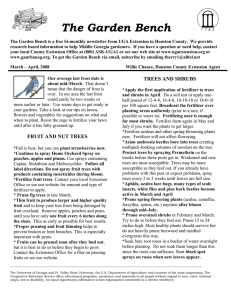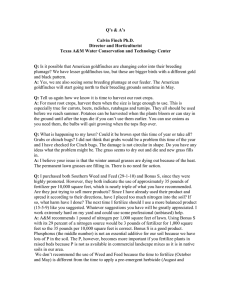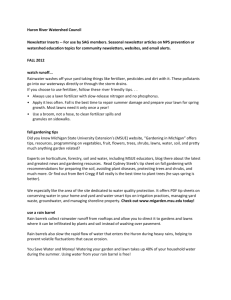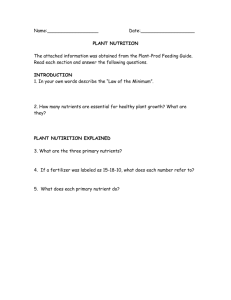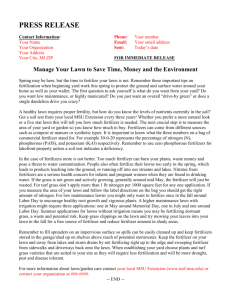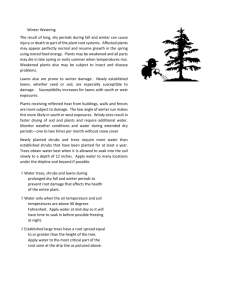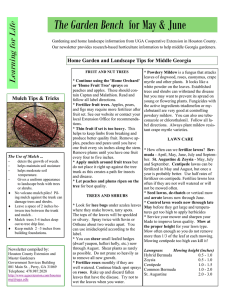The Garden Bench March / April 2010
advertisement
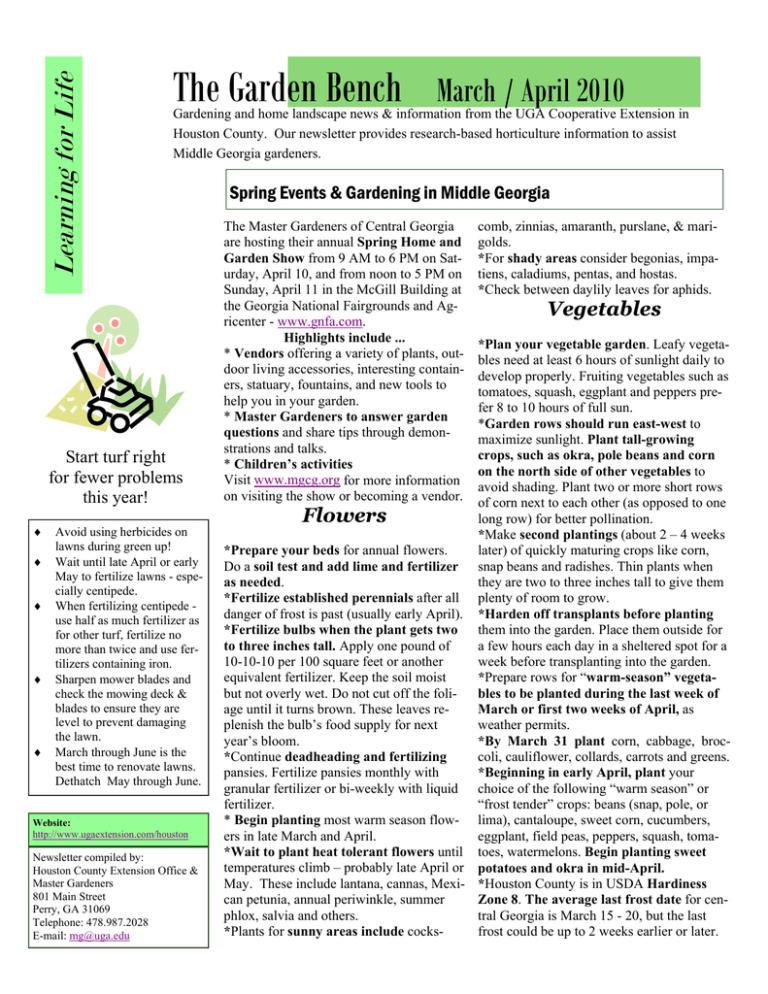
Learning for Life The Garden Bench Start turf right for fewer problems this year! ♦ ♦ ♦ ♦ ♦ March / April 2010 Gardening and home landscape news & information from the UGA Cooperative Extension in Houston County. Our newsletter provides research-based horticulture information to assist Middle Georgia gardeners. Avoid using herbicides on lawns during green up! Wait until late April or early May to fertilize lawns - especially centipede. When fertilizing centipede use half as much fertilizer as for other turf, fertilize no more than twice and use fertilizers containing iron. Sharpen mower blades and check the mowing deck & blades to ensure they are level to prevent damaging the lawn. March through June is the best time to renovate lawns. Dethatch May through June. Website: http://www.ugaextension.com/houston Newsletter compiled by: Houston County Extension Office & Master Gardeners 801 Main Street Perry, GA 31069 Telephone: 478.987.2028 E-mail: mg@uga.edu Spring Events & Gardening in Middle Georgia The Master Gardeners of Central Georgia are hosting their annual Spring Home and Garden Show from 9 AM to 6 PM on Saturday, April 10, and from noon to 5 PM on Sunday, April 11 in the McGill Building at the Georgia National Fairgrounds and Agricenter - www.gnfa.com. Highlights include ... * Vendors offering a variety of plants, outdoor living accessories, interesting containers, statuary, fountains, and new tools to help you in your garden. * Master Gardeners to answer garden questions and share tips through demonstrations and talks. * Children’s activities Visit www.mgcg.org for more information on visiting the show or becoming a vendor. comb, zinnias, amaranth, purslane, & marigolds. *For shady areas consider begonias, impatiens, caladiums, pentas, and hostas. *Check between daylily leaves for aphids. Vegetables *Plan your vegetable garden. Leafy vegetables need at least 6 hours of sunlight daily to develop properly. Fruiting vegetables such as tomatoes, squash, eggplant and peppers prefer 8 to 10 hours of full sun. *Garden rows should run east-west to maximize sunlight. Plant tall-growing crops, such as okra, pole beans and corn on the north side of other vegetables to avoid shading. Plant two or more short rows of corn next to each other (as opposed to one Flowers long row) for better pollination. *Make second plantings (about 2 – 4 weeks later) of quickly maturing crops like corn, *Prepare your beds for annual flowers. Do a soil test and add lime and fertilizer snap beans and radishes. Thin plants when they are two to three inches tall to give them as needed. *Fertilize established perennials after all plenty of room to grow. danger of frost is past (usually early April). *Harden off transplants before planting *Fertilize bulbs when the plant gets two them into the garden. Place them outside for a few hours each day in a sheltered spot for a to three inches tall. Apply one pound of week before transplanting into the garden. 10-10-10 per 100 square feet or another *Prepare rows for “warm-season” vegetaequivalent fertilizer. Keep the soil moist but not overly wet. Do not cut off the folibles to be planted during the last week of March or first two weeks of April, as age until it turns brown. These leaves reweather permits. plenish the bulb’s food supply for next *By March 31 plant corn, cabbage, brocyear’s bloom. coli, cauliflower, collards, carrots and greens. *Continue deadheading and fertilizing *Beginning in early April, plant your pansies. Fertilize pansies monthly with granular fertilizer or bi-weekly with liquid choice of the following “warm season” or “frost tender” crops: beans (snap, pole, or fertilizer. * Begin planting most warm season flow- lima), cantaloupe, sweet corn, cucumbers, eggplant, field peas, peppers, squash, tomaers in late March and April. *Wait to plant heat tolerant flowers until toes, watermelons. Begin planting sweet temperatures climb – probably late April or potatoes and okra in mid-April. May. These include lantana, cannas, Mexi- *Houston County is in USDA Hardiness Zone 8. The average last frost date for cencan petunia, annual periwinkle, summer tral Georgia is March 15 - 20, but the last phlox, salvia and others. *Plants for sunny areas include cocksfrost could be up to 2 weeks earlier or later. Spring Landscape & Garden Tips Trees and Shrubs *Prune spring flowering plants (azalea, camellia, forsythia, spirea, etc.) anytime after bloom through mid-July. Prune non-blooming plants from January - September 1. * Prune oversized shrubs in February and March. Try to do so before they bud out. Prune 12 to 24 inches high. Most healthy plants should survive but do not heavily prune boxwood and needled evergreens (pine, juniper, etc.) this way. *Apply the first application of fertilizer to trees and shrubs in April. Do a soil test or apply one-half pound of 12-4-8, 16-4-8, 10-10-10 or 18-0-18 per 100 square feet. Broadcast the fertilizer over planting areas uniformly (prior to a rain if possible or water it in). Fertilizing once is enough for most shrubs. Fertilize them again in May and July if you want the plants to get larger. *Fertilize azaleas and other spring-blooming plants now. Fertilizer will not affect flowering. *Asian ambrosia beetles bore into trees creating toothpicklooking columns of sawdust on the tree. Protect trees by spraying Permethrin on the trunks before these pests get in. Weakened and new trees are most susceptible. Trees may be more susceptible as they leaf out. If you already have problems with this pest or expect problems, spray trees every 2 to 3 weeks from budbreak until leaves are full size. Fruits and Nuts *Continue to spray Home Orchard Spray on peaches, apples and plums. Use sprays containing Captan, Malathion and Methoxychlor. Follow all label directions. Do not spray fruit trees with products containing insecticides during bloom. *Fertilize fruit trees. Contact your local Extension Office or see our website for amount and type of fertilizer to apply. * Clean the orchard if fruit or dead limbs remain from last year. Remove all these and any other dead limbs, leaves etc. from the orchard. These can harbor diseases. * Prune fig trees in late March. *Thin fruit to produce larger and higher quality fruit and to keep your tree from being damaged. Remove apples, peaches and pears until you have only one fruit every 6 inches along the stem. Thin as early as possible. *Proper pruning and fruit thinning helps to prevent broken or bent branches - especially with pears. * Fruits can be pruned soon after they bud out, but it is best to do so before they begin to grow. Contact the Extension Office for a flier on pruning fruits or see our website. * Fertilize pecans in May if you did not in February. Lawns *The single most effective step you can take to improve your lawn is to mow at the proper height for the type of lawn grass you have. Be sure the mower blades are sharp and sit evenly for best results. Worn mower blades tear the grass blade and may pull out sections of the lawn. Lawn grass Mowing height (inches) Hybrid Bermuda & Zoysia 0.5 - 1.0 Centipede 1.0 - 1.5 Common Bermuda 1.0 - 2.0 St. Augustine 2.0 - 3.0 *Fertilize your lawn after it fully greens up – usually in late April or May. Wait until late April or May to seed. *High mowing height and too early or heavy fertilization can damage or kill centipede lawns! *Control summer lawn weeds now through late May, before they get large and the temperature gets too high. Do not use pre-emergence herbicides on lawns the first year. * Water lawns and shrubs with about 3/4 to 1 inch of water when they get dry. Dry areas of the lawn will look grey or have rolled or wilted leaves. Footprints show in dry lawns after they are walked on. Water when lawns begin to dry - do not water every other day! Over watered lawns look okay, but they are often weak and prone to problems. The Garden Bench is available on our website, www.ugaextension.com/houston along with archived editions. If you wish to receive an email notice that the latest edition is available, please email tberry1@windstream.net Web Resources Cooperative Extension is an equal opportunity/affirmative action organization. Call your local County Extension Office at (800) ASK-UGA1 or find them online www.caes.uga.edu/extension/office.cfm Houston County Cooperative Extension http://www.ugaextension.com/houston UGA Cooperative Extension http://www.caes.uga.edu/extension/ Gardening & Landscape Information from the UGA Center for Urban Agriculture www.gaurbanag.org
